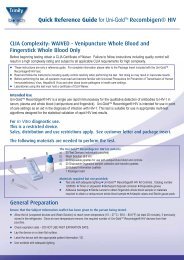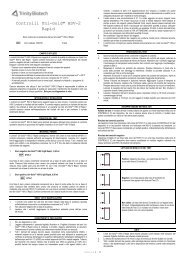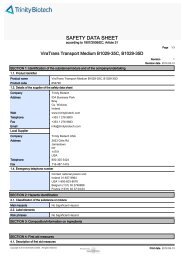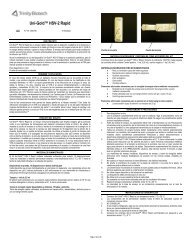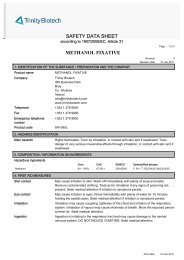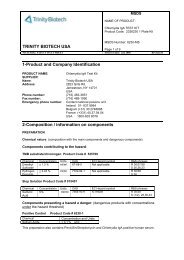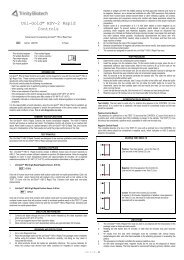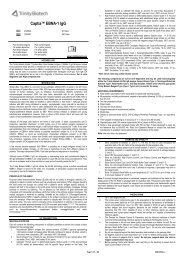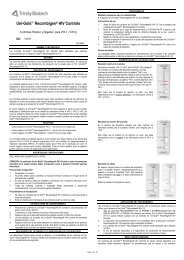Hemoglobin A1c Controls - Trinity Biotech PLC
Hemoglobin A1c Controls - Trinity Biotech PLC
Hemoglobin A1c Controls - Trinity Biotech PLC
You also want an ePaper? Increase the reach of your titles
YUMPU automatically turns print PDFs into web optimized ePapers that Google loves.
<strong>Hemoglobin</strong> <strong>A1c</strong> <strong>Controls</strong><br />
fREFf 01-04-0015 fCONf<br />
Pour d'autres langues<br />
Für andere Sprachen<br />
Para otras lenguas<br />
Per le altre lingue<br />
Dla innych języków<br />
Para outras línguas<br />
Για τις άλλες<br />
λώσσες<br />
För andra språk<br />
For andre språk<br />
1 x 400 µL Level I Control<br />
1 x 400 µL Level II Control<br />
www.trinitybiotech.com<br />
INTENDED USE<br />
<strong>Hemoglobin</strong> <strong>A1c</strong> (Hb<strong>A1c</strong>) <strong>Controls</strong> are intended for the control of quantitative <strong>Hemoglobin</strong> <strong>A1c</strong><br />
affinity assays. For in vitro diagnostic use only. fIVDf<br />
SUMMARY AND EXPLANATION OF THE TEST<br />
Recognition of the usefulness of <strong>Hemoglobin</strong> <strong>A1c</strong> in the control of diabetes has led to a<br />
substantial demand for its measurement by clinical laboratories. 1,2,3,4,5 Reliable use of the data<br />
generated necessitates good accuracy and precision in the <strong>Hemoglobin</strong> <strong>A1c</strong> measurement.<br />
Factors such as pH, ionic strength, temperature, dilution and column equilibration can affect the<br />
performance of the assay. In order to assure the accuracy and precision of this assay, high quality<br />
Control material should be used. The <strong>Trinity</strong> <strong>Biotech</strong> <strong>Hemoglobin</strong> <strong>A1c</strong> <strong>Controls</strong> were developed to<br />
assist with these requirements.<br />
Good laboratory practice provides a system of management controls to ensure the consistency<br />
and reliability of analytical results (e.g., standard operating procedures, uniform sample collection<br />
and handling practices, performance training of personnel, statistical evaluation of control results,<br />
proper storage of test kits and controls, a permanent record of control results, etc.). Use of<br />
external control samples assures the test reagents are working properly, that the <strong>Trinity</strong> <strong>Biotech</strong><br />
Affinity <strong>Hemoglobin</strong> <strong>A1c</strong> analyzer is calibrated properly, and that the operator has performed the<br />
test correctly. If the controls do not perform as expected (i.e., within given acceptance ranges),<br />
review the instructions for use to see if the test was performed correctly; repeat the test or contact<br />
<strong>Trinity</strong> <strong>Biotech</strong> Technical Service before testing patient samples.<br />
The staff at each laboratory site will benefit by establishing a quality assurance plan, based on<br />
their institution’s policies. Run quality control specimens, for example, under the following<br />
conditions:<br />
At regular intervals determined by the laboratory procedures<br />
With each new shipment of reagents and with each new lot of reagents<br />
Each time a calibration is performed<br />
To train and confirm performance acceptability for new analysts<br />
When results do not match the patient’s clinical condition or symptoms<br />
Good laboratory practices include a well-designed and implemented quality control process. These<br />
practices, for example, may involve:<br />
Proper storage and handling of reagents kits<br />
Careful sample collection and handling procedures<br />
Training of testing personnel<br />
Routine review of sample and control results<br />
Periodic quality system reviews<br />
Retention of quality control testing records<br />
If the problem cannot be corrected, or the reason for an out-of-limits result cannot be determined,<br />
contact <strong>Trinity</strong> <strong>Biotech</strong> or the <strong>Trinity</strong> <strong>Biotech</strong> Distributor nearest you.<br />
PRINCIPAL OF THE PROCEDURE<br />
Utilizing the principles of boronate affinity and high-performance liquid chromatography (H<strong>PLC</strong>),<br />
the assay separates and quanitates <strong>Hemoglobin</strong> <strong>A1c</strong> in whole blood and hemolysates of whole<br />
blood. <strong>Hemoglobin</strong> <strong>A1c</strong> is separated from non-<strong>Hemoglobin</strong> <strong>A1c</strong> which are then quanitated with an<br />
Hb<strong>A1c</strong> result generated based on that ratio.<br />
PRECAUTIONS<br />
CAUTION: For In Vitro Diagnostic fIVDf Use ONLY<br />
SAFETY GLASSES, GLOVES AND LAB COAT ARE RECOMMENDED<br />
WHEN USING THE TRINITY BIOTECH HEMOGLOBIN A1C CONTROLS.<br />
DO NOT USE: If diluted sample turns dark brown.<br />
POTENTIALLY BIOHAZARDOUS MATERIAL<br />
Human sourced materials were used in the manufacturing of this product.<br />
This product was found to be non-reactive for hepatitis B surface antigen<br />
(HBsAg), antibodies to hepatitis C (HCV), and antibodies to Human<br />
Immunodeficiency Viruses (HIV-1 and HIV-2), when tested by FDA cleared<br />
methods. No known test method can offer assurance that products derived from<br />
human blood will not transmit disease, and material should be handled as such.<br />
PREPARATION PROCEDURE<br />
RECONSTITUTION<br />
1. Remove the seal and stopper from the vial.<br />
2. Add 400µL of <strong>Trinity</strong> <strong>Biotech</strong> Diluent to the vial. <strong>Trinity</strong> <strong>Biotech</strong> Diluent fREFf 01-03-0013<br />
(DIL, 940mL), 01-03-0056 (2DIL, 3.8L), 01-03-0059 (2DIL, 940mL), 01-03-0066 (PDQ DIL)<br />
or 01-03-0097 (Premier Hb9210 DIL Reagent). Replace stopper. Allow the vial to stand<br />
for ten minutes, then rotate gently until completely dissolved.<br />
3. For further dilution treat the control as whole blood.<br />
DILUTIONS<br />
Following instructions below, dilute the reconstituted <strong>Hemoglobin</strong> <strong>A1c</strong> <strong>Controls</strong> using <strong>Trinity</strong> <strong>Biotech</strong><br />
Diluent in the same manner required in the assay for a patient sample. The reconstituted<br />
<strong>Hemoglobin</strong> <strong>A1c</strong> <strong>Controls</strong> have the same hemoglobin concentration as whole blood.<br />
Typical Dilution<br />
System/Injector with Dilution<br />
µL Control : µL<br />
Vial Type<br />
Injection Volume (L) Ratio<br />
Diluent<br />
Premier Hb9210 (5L) 1:150 10:1490 Untreated Test Tube<br />
PDQ / PDQ PLUS (10L) 1:100 20:1980 Untreated PDQ Tube<br />
ultra 2 /CLC385 w/215 (20L) 1:200 5:995 (or 8:1592) Shell or Crimp Top<br />
CLC385 w/234 (20L) 1:200 3:597 ‘234 Vial’<br />
CLC385 w/234 (5L) 1:50 10:490 ‘234 Vial’<br />
Prior to making each Control dilution, rotate the <strong>Hemoglobin</strong> <strong>A1c</strong> Control vial gently and ensure<br />
material is uniformly mixed and in solution.<br />
TEST PROCEDURE<br />
After reconstitution and dilution of the <strong>Hemoglobin</strong> <strong>A1c</strong> Control material, it should be analyzed in<br />
the same manner as patient samples.<br />
RESULTS AND INTERPRETATION OF RESULTS<br />
These <strong>Trinity</strong> <strong>Biotech</strong> Control materials have been assigned values utilizing NGSP and/or IFCC<br />
primary Hb<strong>A1c</strong> reference materials. According to these reference materials, each <strong>Trinity</strong> <strong>Biotech</strong><br />
Hb<strong>A1c</strong> system has been assigned a system-specific control range to optimize accuracy. Individual<br />
laboratory means should fall within the corresponding acceptable range; however, laboratory<br />
means may vary from the listed values during the life of this control. Variations over time and<br />
between laboratories may be caused by differences in laboratory technique, instrumentation and<br />
reagents, or by manufacturer test method modifications. It is recommended that each laboratory<br />
establish its own means and acceptable ranges and use those provided only as guides. When<br />
assayed by the <strong>Trinity</strong> <strong>Biotech</strong> H<strong>PLC</strong> Affinity method, the results on each <strong>Trinity</strong> <strong>Biotech</strong> analyzer<br />
should fall within these limits:<br />
REAGENTS / COMPONENTS<br />
1 vial lyophilized <strong>Trinity</strong> <strong>Biotech</strong> <strong>Hemoglobin</strong> <strong>A1c</strong> Level I Control<br />
1 vial lyophilized <strong>Trinity</strong> <strong>Biotech</strong> <strong>Hemoglobin</strong> <strong>A1c</strong> Level II Control<br />
1 Package insert<br />
The <strong>Trinity</strong> <strong>Biotech</strong> Level I and Level II <strong>Hemoglobin</strong> <strong>A1c</strong> <strong>Controls</strong> included in the <strong>Hemoglobin</strong> <strong>A1c</strong><br />
Control Kit are prepared from non-diabetic and glycated non-diabetic whole blood. Each sample<br />
provides a clear, cherry red hemolysate containing oxyhemoglobin with low and high <strong>Hemoglobin</strong><br />
<strong>A1c</strong> values as indicated in the assay data section. Once reconstituted, each vial’s content is 400<br />
µL (microliters) of Control material.<br />
STORAGE AND STABILITY<br />
Lyophilized: Lyophilized vials of <strong>Trinity</strong> <strong>Biotech</strong> <strong>Hemoglobin</strong> <strong>A1c</strong> Control<br />
stored at 2°C – 8°C are stable until the expiration date on the label.<br />
Reconstituted: Once reconstituted, the <strong>Trinity</strong> <strong>Biotech</strong> <strong>Hemoglobin</strong> <strong>A1c</strong><br />
Control is stable at 2°C – 8°C for 30 days.<br />
Diluted: Diluted samples of <strong>Trinity</strong> <strong>Biotech</strong> <strong>Hemoglobin</strong> <strong>A1c</strong> Control are<br />
stable for 8 hours at 20°C – 25°C.<br />
DO NOT USE after the expiration date.
<strong>Trinity</strong> <strong>Biotech</strong> Hb<strong>A1c</strong> Control Set Points and Ranges:<br />
<strong>Trinity</strong> <strong>Biotech</strong> <strong>Hemoglobin</strong> <strong>A1c</strong> Control Kit FLOTf 4150 EXP 2013-10<br />
Premier Hb9210<br />
Units<br />
Control Level I FLOTf 4151 Control Level II FLOTf 4152<br />
RNG<br />
RNG<br />
Hb<strong>A1c</strong> (NGSP) 6 % 5.7 5.4 - 6.0 10.6 10.0 - 11.2<br />
Hb<strong>A1c</strong> (IFCC) 7 S.I.* 39 36 - 42 92 86 - 99<br />
PDQ<br />
Hb<strong>A1c</strong> (NGSP) 6 % 5.5 5.2 - 5.8 10.4 9.8 - 11.0<br />
Hb<strong>A1c</strong> (IFCC) 7 S.I.* 37 34 - 40 90 83 - 97<br />
ultra 2<br />
Hb<strong>A1c</strong> (NGSP) 6 % 5.7 5.4 - 6.0 10.8 10.2 - 11.4<br />
Hb<strong>A1c</strong> (IFCC) 7 S.I.* 39 36 - 42 95 88 - 102<br />
CLC385<br />
Hb<strong>A1c</strong> (NGSP) 6 % 5.7 5.4 - 6.0 10.8 10.2 - 11.4<br />
Hb<strong>A1c</strong> (IFCC) 7 S.I.* 39 36 - 42 95 88 - 102<br />
S.I.* units (Sistème Internationale) = mMol Hb<strong>A1c</strong>/mol Hb<br />
LIMITATIONS<br />
This product should not be used past the expiration date.<br />
If there is evidence of microbial contamination, brown color or excessive turbidity in the<br />
reconstituted Control, discard the vial.<br />
This product is not intended for use as a standard.<br />
REFERENCES<br />
1. Trivelli, New Engl. J. of Med., 284, 353, (1971).<br />
2. Gabbay, K.H., et al., J. Clin. End & Metabl., 44, 859, (1977).<br />
3. Dix, D. et al. Clin. Chem., 25, 877, (1979).<br />
4. Abraham, E.D. Diabetes, 27, 931, (1978).<br />
5. Goldstein, D.E. et al. Diabetes, 31, 70, (1982).<br />
6. Goldstein, D.E. et al., in Methods in Diabetes Research, Vol II, 475-504 (1986).<br />
7. Hoelzel W, et al., Clin.Chem. 2004; 50: 166-174<br />
Kit<br />
Catalog No.<br />
01-04-0015<br />
ORDERING INFORMATION<br />
<strong>Hemoglobin</strong> <strong>A1c</strong> <strong>Controls</strong><br />
Item<br />
Quantity<br />
Kit, <strong>Hemoglobin</strong> <strong>A1c</strong> <strong>Controls</strong> 1 x 400 µL Control I<br />
1 x 400 µL Control II<br />
Users of other methods, including H<strong>PLC</strong> ion-exchange, should determine their own values.<br />
Premier Hb9210<br />
<strong>Hemoglobin</strong> <strong>A1c</strong> Control<br />
Level I<br />
Barcode, lot 4151<br />
ry@fyb(*Ss<br />
Premier Hb9210<br />
<strong>Hemoglobin</strong> <strong>A1c</strong> Control<br />
Level II<br />
Barcode, lot 4152<br />
Py@ByEnp|.<br />
Manufactured<br />
EC REP<br />
Authorized Representative<br />
REF<br />
Product Number<br />
LOT<br />
Lot<br />
Mean Value<br />
European Conformity<br />
Consult accompanying documents<br />
CON<br />
Control<br />
IVD<br />
For In Vitro Diagnostic use<br />
RNG<br />
Range of Acceptable Values<br />
Use by MM-YYYY<br />
Caution, consult accompanying documents<br />
Store Lyophilized Material at 2-8ºC<br />
Store Reconstituted Material at 2-8ºC<br />
Store Diluted Material at 20-25ºC<br />
Primus Corporation<br />
D.B.A. <strong>Trinity</strong> <strong>Biotech</strong><br />
Kansas City, MO 64132<br />
Tel. 1 800-325-3424<br />
Fax: 1 816-361-1974<br />
Hazard<br />
<strong>Trinity</strong> <strong>Biotech</strong> plc<br />
Bray Co. Wicklow, Ireland<br />
Tel. 353 1 2769800<br />
Fax 353 1 2769888<br />
www.trinitybiotech.com<br />
Rev F 05/12<br />
Page 2 of 2 - EN



